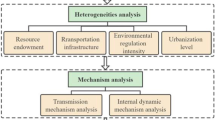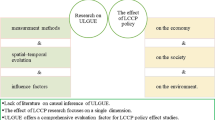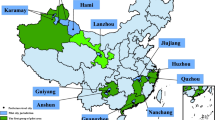Abstract
Low-carbon city (LCC) pilot is a strategic policy to deal with global climate change and energy poverty. Using the city-level data from 2006 to 2019, this paper applies a multiple difference-in-difference (DID) analysis to explore the impact of LCC policy on urban green total factor energy efficiency(GTFEE) and its potential mechanism. The results show that the LCC pilot policy can significantly improve urban GTFEE, and the finding remains robust with various tests. Secondly, we shed light on the mechanism of the LCC policy and explore the possible channels through green innovation and structural upgrading to improve the urban GTFEE. Third, the policy effect is affected by different levels of urban economic development, urban development scale, and urban development types. In cities with higher levels of economic development, super-large resource-based cities, the pilot policy has a more significant improvement effect on GTFEE. On the other hand, in the less developed regions, pilot policies will hinder the improvement of GTFEE.



Similar content being viewed by others
Data availability
The datasets generated and analyzed during the current study are property of the National Bureau of Statistics; they are available from the corresponding author who will inform the National Bureau of Statistics that the data will be released on reasonable request.
Notes
The criteria for classifying urban population size refer to the Notice on Adjusting the Criteria for Classifying Urban population issued by The Chinese State Council in 2014. Cities with a permanent urban population of less than 500,000 are defined as small cities; cities with a permanent urban population of more than 500,000 and less than 1 million are medium-sized cities; cities with a permanent urban population of more than 1 million and less than 5 million are large cities; megacities are those with a permanent urban population of more than 5 million and less than 10 million.
References
Adua L, Clark B, York R (2021) The ineffectiveness of efficiency: the paradoxical effects of state policy on energy consumption in the united states. Energy Res Soc Sci 71:101806
Aldieri L, Gatto A, Vinci CP (2021) Evaluation of energy resilience and adaptation policies: an energy efficiency analysis. Energy Policy 157:112505
Angrist, J. D., & Pischke, J. S. (2008). Mostly harmless econometrics: an empiricist’s companion[M]. Princeton University Press, 221–248.
Bai Y, Deng X, Jiang S, Zhang Q, Wang Z (2018) Exploring the relationship between urbanization and urban eco-efficiency: evidence from prefecture-level cities in China. J Clean Prod 195:1487–1496
Beck T, Levine R, Levkov A (2010) Big bad banks? The winners and losers from bank deregulation in the United States. J Financ 65(5):1637–1667
British Petroleum. BP Statistical Review of World Energy. London. 2019. http://cngascn.com/public/uploads/file/20190805/20190805102652_80658.pdf.
Cheng J, Yi J, Dai S, Xiong Y (2019) Can low-carbon city construction facilitate green growth? Evidence from China’s pilot low-carbon city initiative. J Clean Prod 231:1158–1170
Chien SS, Hong DL (2018) River leaders in China: party-state hierarchy and transboundary governance. Polit Geogr 62:58–67
Cruz C, Montenon A (2016) Implementation and impacts of low emission zones on freight activities in Europe: local schemes versus national schemes. Transp Res Procedia 12:544–556
Curtis EM, Lee JM (2019) When do environmental regulations backfire? Onsite industrial electricity generation, energy efficiency and policy instruments. J Environ Econ Manag 96:174–194
D’Amato A, Valentini E (2011) Enforcement and environmental quality in a decentralized emission trading system. J Regul Econ 40(2):141–159
Dai, L., Dai, L., & Yurova. (2019). Politics and governance in water pollution prevention in China. Springer International Publishing.
Dowlatabadi H, Oravetz MA (2006) US long-term energy intensity: backcast and projection. Energy Policy 34(17):3245–3256
Du, M., Antunes, J., Wanke, P., & Chen, Z. (2021). Ecological efficiency assessment under the construction of low-carbon city: a perspective of green technology innovation. Journal of Environmental Planning and Management, 1–26.
Duan K, Ren X, Shi Y, Mishra T, Yan C (2021) The marginal impacts of energy prices on carbon price variations: evidence from a quantile-on-quantile approach. Energy Economics 95:105131
Dubey R, Gunasekaran A, Childe SJ, Papadopoulos T, Luo Z, Wamba SF, Roubaud D (2019) Can big data and predictive analytics improve social and environmental sustainability? Technol Forecast Soc Chang 144:534–545
Fan, G., &Wang, X. L. (2019) Marketization Index Report of China by Province (version 2018) [M].
Ferreira JJ, Fernandes C, Ratten V (2019) The effects of technology transfers and institutional factors on economic growth: evidence from Europe and Oceania. J Technol Transf 44(5):1505–1528
Fredriksson PG, Wollscheid JR (2014) Environmental decentralization and political centralization. Ecol Econ 107:402–410
Fujita, M., Krugman, P. R., & Venables, A. (1999). The spatial economy: cities, regions, and international trade. MIT press.
Gan CH, Zheng RG, Yu DF (2011) An empirical study on the effects of industrial structure on economic growth and fluctuations in China. Econ Res J 5:4–16
Gao D, Li Y, Yang Q (2021b) Can pollution charges reform promote industrial SO2 emissions reduction?—Evidence from 189 China’s cities. Energy Environ 32(1):96–112
Gao, D., Li, G., Li, Y., & Gao, K. (2021a). Does FDI improve green total factor energy efficiency under heterogeneous environmental regulation? Evidence from China. Environmental Science and Pollution Research, 1–14.
Gehrsitz M (2017) The effect of low emission zones on air pollution and infant health. J Environ Econ Manag 83:121–144
Hancevic PI (2016) Environmental regulation and productivity: the case of electricity generation under the CAAA-1990. Energy Econ 60:131–143
Hassler, J., Krusell, P., & Olovsson, C. (2012). Energy-saving technical change (No. w18456). National Bureau of Economic Research.
Hayes AF (2009) Beyond Baron and Kenny: statistical mediation analysis in the new millennium. Commun Monogr 76(4):408–420
Hicks, J. R. (1932). The Theory of Wages Macmillan and Co. Ltd., London.
Li PS, Chen YY (2019) Environmental regulation, bargaining power of enterprises and green total factor productivity. Financ Trade Econ 40(11):144–160
Li B, Wu S (2017) Effects of local and civil environmental regulation on green total factor productivity in China: a spatial Durbin econometric analysis. J Clean Prod 153:342–353
Li B, Wu L (2018) Development zone and firms’ growth: research on heterogeneity and mechanism. China Ind Econ 4:79–97
Li, G., Gao, D., & Li, Y. (2022). Dynamic environmental regulation threshold effect of technical progress on green total factor energy efficiency: evidence from China. Environmental Science and Pollution Research, 29(6): 8804–8815
Liu C, Zhou Z, Liu Q, Xie R, Zeng X (2020) Can a low-carbon development path achieve win-win development: evidence from China’s low-carbon pilot policy. Mitig Adapt Strat Glob Change 25(7):1199–1219
Lu Y, Tao Z, Zhu L (2017) Identifying FDI spillovers. J Int Econ 107:75–90
Oates WE (1999) An essay on fiscal federalism. J Econ Lit 37(3):1120–1149
Porter ME, Van der Linde C (1995) Toward a new conception of the environment-competitiveness relationship. J Econ Perspect 9(4):97–118
Qi S, Lin S, Cui J (2018) Do environmental rights trading schemes induce green innovation? Evidence from listed firms in China. Econ Res J 53:129–143
She S, Wang Q, Zhang A (2020) Technological innovation, industrial structure and urban GTFP—channel test based on national low-carbon city pilots. Res Econ Manag 41:44–61
Shi B, Shen KR (2013) The government intervention, the economic agglomeration and the energy efficiency. Manage World 10:6–18
Shi D, Ding H, Wei P, Liu J (2018) Can smart city construction reduce environmental pollution. China Ind Econ 6:117–135
Song H, Sun Y, Chen D (2019) Assessment for the effect of government air pollution control policy: empirical evidence from “low-carbon city” construction in China. Manage World 35(6):95–108
Song M, Zhao X, Shang Y (2020) The impact of low-carbon city construction on ecological efficiency: Empirical evidence from quasi-natural experiments. Resour Conserv Recycl 157:104777
Syahza, A., & Asmit, B. (2019). Regional economic empowerment through oil palm economic institutional development. Management of Environmental Quality: An International Journal, 30(6):1256–1278
Tan S, Yang J, Yan J, Lee C, Hashim H, Chen B (2017) A holistic low carbon city indicator framework for sustainable development. Appl Energy 185:1919–1930
Tone K, Tsutsui M (2010) An epsilon-based measure of efficiency in DEA–a third pole of technical efficiency. Eur J Oper Res 207(3):1554–1563
Wang B (2017) Review of environmental policy and technological innovation. Econ Rev 04:131–148
Wei C, Shen M (2008) Can structural adjustment improve energy efficiency: a study based on Chinese provincial data[J]. J World Econ 11:77–85
Wen H, Lee CC, Zhou F (2021a) Green credit policy credit allocation efficiency and upgrade of energy-intensive enterprises. Energy Economics 94:105099
Wen H, Li N, Lee CC (2021b) Energy intensity of manufacturing enterprises under competitive pressure from the informal sector: evidence from developing and emerging countries. Energy Econ 104:105613
Xiong S, Ma X, Ji J (2019) The impact of industrial structure efficiency on provincial industrial energy efficiency in China. J Clean Prod 215:952–962
Xu J, Cui J (2020) Low-carbon cities and green technology innovation of enterprises[J]. China Ind Econ 12:178–196
Yan D, Kong Y, Ye B, Shi YK, Zeng XY (2019) Spatial variation of energy efficiency based on a super-slack-based measure: evidence from 104 resource-based cities. J Clean Prod 240:117669
Yang Y, Xue R, Yang D (2020) Does market segmentation necessarily discourage energy efficiency? PLoS ONE 15(5):e0233061
Yu Y, Zhang N (2021) Low-carbon city pilot and carbon emission efficiency: Quasi-experimental evidence from China. Energy Econ 96:105125
Zhao ZY, Gao L, Zuo J (2019) How national policies facilitate low carbon city development: A China study. J Clean Prod 234:743–754
Funding
This study was financed by Huazhong University of Science and Technology Special Funds for Development of Humanities and Social Sciences.
Author information
Authors and Affiliations
Contributions
Da Gao and Yi Li conceived and designed the research question. Yi Li constructed the models and analyzed the optimal solutions. Da Gao and Yi Li wrote the paper. Da Gao, and Ge Li reviewed and edited the manuscript. All authors read and approved the manuscript.
Corresponding author
Ethics declarations
Ethics approval and consent to participate
Not applicable.
Consent to participate
Not applicable.
Consent to publish
Not applicable.
Conflict of interest
The authors declare no competing interests.
Additional information
Responsible Editor: Roula Inglesi-Lotz
Publisher's note
Springer Nature remains neutral with regard to jurisdictional claims in published maps and institutional affiliations.
Rights and permissions
About this article
Cite this article
Gao, D., Li, Y. & Li, G. Boosting the green total factor energy efficiency in urban China: Does low-carbon city policy matter?. Environ Sci Pollut Res 29, 56341–56356 (2022). https://doi.org/10.1007/s11356-022-19553-9
Received:
Accepted:
Published:
Issue Date:
DOI: https://doi.org/10.1007/s11356-022-19553-9




